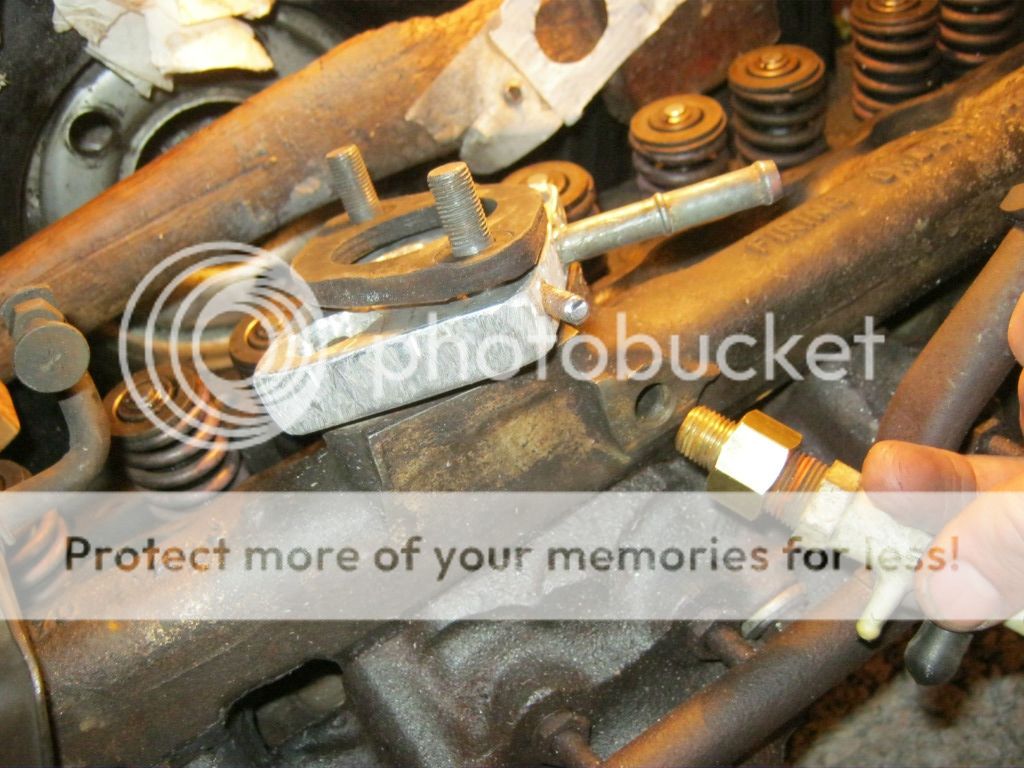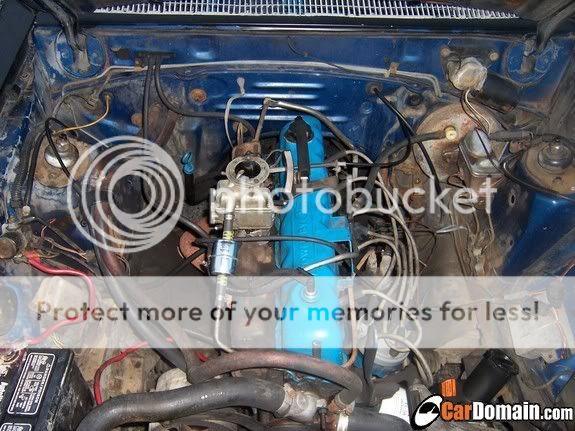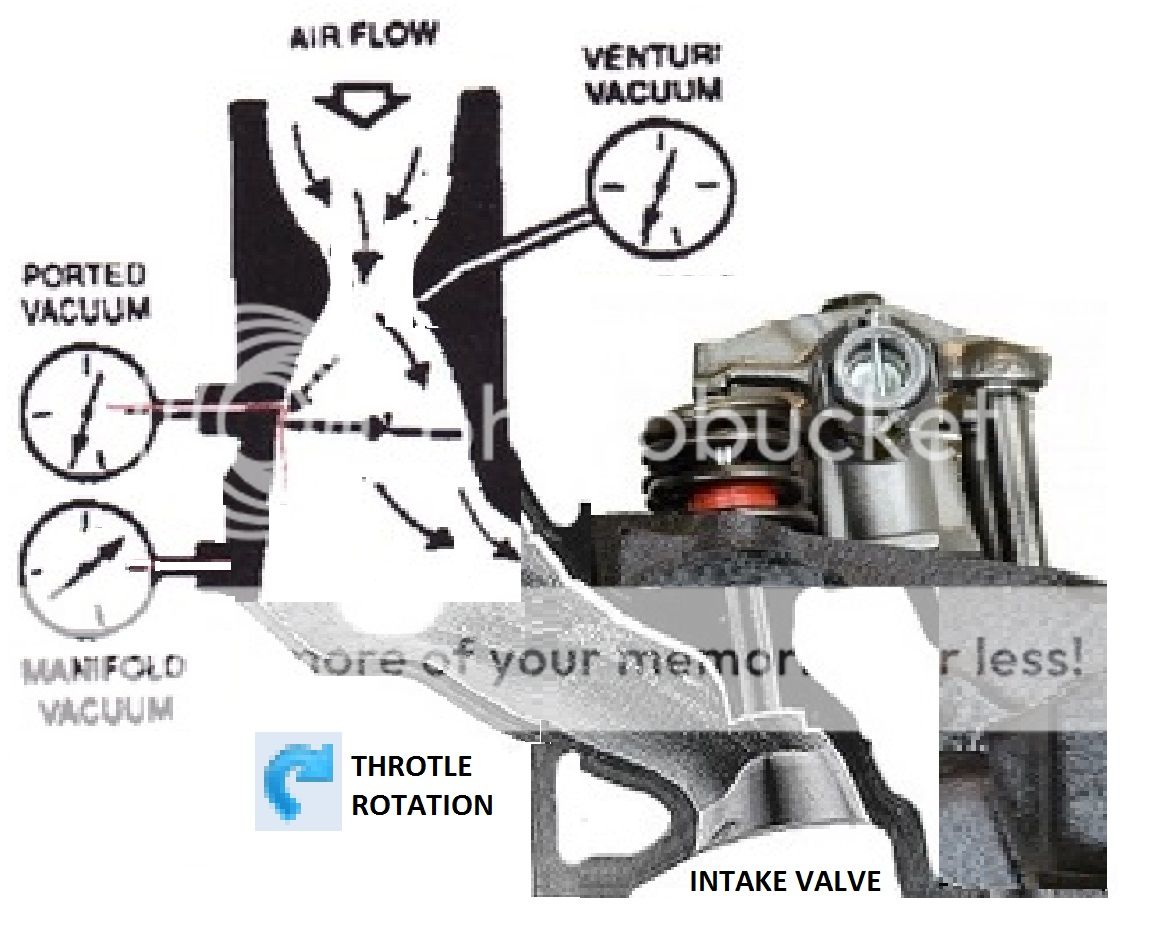Hot 6t Falcon and
CZLN6
This is the all encompassing Thermactor/ IMCO and pre Port EFI list formed from 5 years work on the photo's and descriptions from consultation with four other websites, and a lot of very good, very helpfull people. For our EFI Big Six guys, these terms help, although they don't include TFi, PIP, SPOUT, and the details which most owners have quickly learned from the modern Injection world, and its much easier than the 1978 to 1983 3.3 small six and 1978 to 1980 4.1 small six era.
Fordsix.Com is the first and foremost, but
the Ford Truck Forum then
Four Eyed Pride,
and lastly, two other Australian Ford forums helped me compile it.
Due to Thermactor and IMCO (Ford's new IMCO [Improved Combustion] emissions control was an integral part of light duty passenger cars),
engineering terms having quite specific operations, I've had to repeat
Ten or so Items
8,
33,
34,
53,
73,
plus the letters
A,
E,
S,
SOL V,
BV
They are not perfect, due to the way Ford has to change and evolve the nomenclature. Ported Vacuum sources are a dirty word in the emissions era, so a whole lot of things had to change over the years.
Note too that Ford uses one kind of component to create another.
Item 27, the TVS (Thermal Vacuum Swithc Valve), is clearly stamped TVS, but called and listed as something else, and color code governs the Ford actualtion temperature and rating.
An item code for DV doesn't exist because a DV (Delay Valve), creates other parts. Eveen though for example, AMC Jeep used Ford emission and EVAP parts, the so called DV valves are color code many different ways, and used to create many, many other devices with DV in them as you might see below.
Again, all DV's are coded by color for delay time.
Often, the Green ones aren't avaliable, so pepole are forced to use non standard colors/shade or parts because they re used as Air Cleaner Cold Weather Modulator CWM. The Green TVS stamped device wasn't around on line. Same with Blue Black or Yellow ones. Stamped TVS, but actually called other names by Ford.
Here is a near match to a Green TVS, a Pink TVS, which won't have exactly the right leak pressure as per the 1985 Ford EVTM
The other CWM (TVS) colors for 3.3's are Blue and Green
For 4.9 Bix Sixes and other F-truck and E-Van vehicles, white and green
Ratings ex Ford Truck Enthusiasts, and FSP member Luke76
https://www.ford-trucks.com/forums/1157 ... ld-39.html
Note Well:
Bubba's yellow CWM numbers in last column are transposed (around the wrong way) according to Fords 1985 EVTM .
http://myzephyrs.com/vac_part_name.htm and everyone in parts list them as 9A995, or Air Cleaner TVS
See
http://vb.foureyedpride.com/showthread. ... ost1819914
mrriggs":1f09g866 said:
I realize this is an old thread but it keeps coming up in my searches to make heads or tails of the vacuum system.
I found this list of FORD vacuum delay valves which may be more relevant to our cars than the list previously linked to.
The list was found here,
http://www.1bad6t.com/Maverick/repair/emission_controls_02.html
1bad6t...FordSix member
It gets worse, because each part for an Thermactor to IMCO 1968 onwards Ford Emission part has a Ford Part Number, with a calibration for that engine and gearbox type, even Air Con or Power Steering changes the air cleaner or Emissions parts. Electrical and Vacuum routing Trouble Shooting manuals help a little, but they won't always tell you what is, or was, supposed to be there
Best advice is that the car is the Vehicle Emission Control Information Diagram... the codes like a Brown colored OEM Air Control Valve # E1BE-9F491-BA For 1981 3.3 B VIN code Mustang, are specfic to THAT vehicle, and not a charted color.
fb71":1f09g866 said:
The problem is that they don't indicate which part/engineering number applies to which vehicle. I need an old parts microfiche for that (don't have a fiche reader anyway), or someone to document what parts are on their application.
85MUSTANGTGT":1f09g866 said:
......Something you might look for is an emission diagnosis manual for your year. I just snagged this one off eBay for my '85, came in the mail today. Have only flipped through it, but lots of info and component descriptions.
The following is the best list I could manage.
0 VECI: Vehicle Emission Control Information, a Diagram detail
1 A/CL: according to Ford, that IS the air cleaner
2 A/CL DV: Air Cleaner Duct & Valve
3 A/CL BI MET: Air Cleaner Bi-Metallic Valve
4 A/CL CWM: Air Cleaner Cold Weather Modulator
5 ACV: Air Control Valve
6 AIR: This is a Secondary air injection Ford calls the Thermactor, short for Thermal Reactor. CA vehicles are installed with it as standard. Air Injection Reaction is what it stands for.
The thermactor system consists mainly of the air pump, the air pump diverter and bypass valves, TAB and TAD solenoids (if equipped) and the catalytic converter.
7 AIR BPV: Air Bypass Valve (aka Thermactor Air Bypass TAB)
8
BV: Bowl Vent (on top of the float tanks)
9 CARB: Carburetor
10 CPRV: Canister Purge Valve ( PURGE CV : )
11 DIST : Distributor of course.
12 EGR: Exhaust Gas Recirculator
13 EFCA: Electronic Fuel Control Assembly (ie Central Fuel Injection or Throttle Body Injection on EECIII and EECIV CFi "EFI" Fords)
14 FLTR: Filter
15 FPR: Fuel Pressure Regulator
16 IVV: Thermactor Idle Vacuum Valve
17
MAN VAC: Indicating Manifold vacuum-Vacuum source
18 MAP: Manifold Absolute Pressure (BMAP: Bariometric Manifold Absolute Pressure, in the case of CFi 5.0 EECIII cars from 1979 to 1985)
19 SOL V: Solenoid Valve
20 SV-CBV: Carburetor Fuel Bowl Solenoid Vent Valve
21
V VAC: short for Vacuum
22 VCKV: Vacuum Check Valve
23 VRESER: Vacuum Reservoir (Actually VRESER just stands for Vacuum Reservoir. It may or may not have a valve or Solenoid Valve inside it.
24 VREST is a vacuum restriction, usually at the thermally controlled valve on top of the thermostat housing.
*On 87 4V 460 F250 truck it is a simple Blue plastic orifice inline with the vacuum line. On 81 IV 200, Pink plastic orifice inline with the vacuum line
25 VRV: Vacuum Regulator Valve
26 VRDV: Vacuum Retard Delay Valve, as these can be used on more than just the distributor.
27 TVS: Thermal Vacuum Switch, and is different to a Dashpot. On Fords these are usualy located in the air cleaner. IMPORTANT: Color defines Fords VECI Name, although clearly stamped TVS, they are called Item 4 A/CL CWM: Air Cleaner Cold Weather Modulator's and may be Green, Purple, Grey, White, Black or Yellow with a different rating based on color.
28 TVV: Thermal Vent Valve. On Fords they are mostly controlled by ambient air temps. Simular to a TVS. Located between the carb and the charcoal cannister.
29 PVS: Ported Vacuum Switch: Very similar to TVVs except on Fords they are used in the cooling system and are controlled by water temps.
30 PURGE CV: Vapor Canister Purge Valve
31 EVAP CANISTER ASY
32 ISC: Ford refers to theirs as an Idle Speed Control (ISC) solenoid. Others mis-use the Idle Air Contro (IAC) term
33 Idle Boost Solenoid (Orange Knob on 81, 82, 83 A/C Equiped 3.3's) or Throttle Kicker Control (TK)
34 Carburettor Throttle Solenoid Positioner (Anti Dieseling Valve/Idle Stop Solenoid)
35
S Spark Port
36 EGR Actuator
37
E EGR Port
38 CATALYST or CAT is catalytic converter (VECI Diagram detail is CATALYST)
39 ENG is engine;
40 ACT - not sure, but on EFIs it means Air Charge Temperature sensor
41 Inlet Air Temperature Control
42 Green DVCV 2 port PVS Vaccum Switches
43 Blue TCVV 3 Port Vaccum Switches
44 Dual Diaphram Distibutor
45 Black SDV Cold Start Spark Delay valve
46 Black SDV EGR Vaccuum delay valve
47 Deceleration Valve (PVS Cold Start lockout Dampened, Non Dashpot)
48 Non dampened or 2 port PVS (dampened) control EGR
49 Attitude and Position Fuel Trap
50 PVS Vacuum with Sintered Line Filters
51 Close Limit primary or Main Jets,
52 Lead plug sealed idle screws
53 Carburettor Throttle Solenoid Positioner (Repeat of 34, Anti Dieseling Valve/Idle Stop Solenoid)
54 Evaporative Emmission Control System
55 Anti Backfire Valve
56 EGR Valve Actuator
57 Vacuum Regulator/Solenoid
58 SOL V: Solenoid Valve ( Repeat of 19 )
59 Venturi Vacuum Amplifier
60 Load Control Valve
61 EGR B/P Transducer
62 Signal Conditioner
63 Ported Pressure Switch
64 Vent Valve Vacuum
65 Vacuum Controlled Switch
66 Vacuum Controlled Switch (Cold Temp)
67 Vacuum Controlled Switch (Decel Idle)
68 Vacuum Delay Valve
69 Vacuum Vent Valve
70 Delay Valve Two Way
71 Ignition Timing Vacuum Switch
72 Ignition Pressure Switch
73 TK (Throttle Kicker)
74 Mushroom caps for charcoal fuel vapor canister vents (VECI Diagram detail).
75 CARB BV (VECI Diagram detail, Repeat of 8
BV: Bowl Vent [on top of the float tanks])
76 FUEL T (VECI Diagram detail)
77 SLEEVE (VECI Diagram detail)
78 TO ATMOS (VECI Diagram detail)
79 VAC-SWITCH ASSY (VECI Diagram detail)
80 SA-FV: Separator Assembly Fuel / Vaccum (VECI Diagram detail)
81 PCV: Positive Crankcase Ventilation (VECI Diagram detail)
82
A : Area to apply Hand Vacuum Pump test (VECI Diagram detail, often multiple 2X)
83 Anti B/F : Anti Back Fire
84 HEAT VLV : Heat Riser Valve (Drivers side Header Heat Riser in some cases)
85 HICV : Hot Idle Control Valve
86 VOLTM : Vacuum Operated Load Throttle Modulator
87 VOTM : Vacuum Operated Throttle Modulator (Variation on 34 and 53 Carburettor Throttle Solenoid Positioner, 73 TK [Throttle Kicker])
88 VR/S: Vaccum Regulator Solenoid
89 VRDM : Vacuum Retard Delay Modulator
90 DUMP : Dump (Open to Air, VECI Diagram detail)
91 DIV : Diverter (VECI Diagram detail)
92 LCV : Load Control Valve
93 Vac Switch Assembley (Like SOL V, only vac operated, Refer Item 33, Idle Boost Solenoid [Orange Knob on 81, 82, 83 A/C Equiped 3.3's] used as a kind of Throttle Kicker Control [TK], but to contol base idle)
Add you own...I think there are lots of compenstator fender apron air bleeds for hi alt states like CO, and Smog Nazi states like CA, shift indicators and other exciting Works in progress I havent touched yet....
VECI diagrams use LOTS of other codes, like finally describing the PCV valve (not present on many VECI'S), but then using heat(ed) control exhaust valves as HCV on later ones, and change from Themactor BPV to ABV, ACV and TAD/TAB and T Kicker under two different names, as well as MAP sensors, and other mysteries during the EECIV era, so you have to go back to this Olde Worlde Ford Flying Toilet grocery list, and figure out Whats likely to be What.
The best forms of the art are the colored M code 4BBL 5.0 HO Mustangs of 1983-1985.
As I say, google or chrome or firefox an online screen dump or link to full size 83 4BBL HO 4V VECI, and find as well the colored one with the codes.
The VECI code for any 80 to date under-hood schematic is XXX with an E3 Something BPN no.
I've found it best to use the Seven color breakout RGOYWBP. Um, okay, blacks not a color, so I guess its "Fords One not color and Six-Color Alphabet" color code
Color Codes to do Vacuum Diagram
[highlight=red]Red[/highlight] = Main vacuum
[highlight=green]Green[/highlight] = EGR function
[highlight=orange]Orange[/highlight] = Heat control Valve (exhaust & intake) (AKA heat riser but more complex)
Yellow[highlight=yellow]Yellow[/highlight] = Distributor advance
White = EGR vacuum (source)
Black = Mainly used for the Evaporative emissions control
Black = Thermactor ACV or Diverter valve
[highlight=blue]Blue[/highlight] = Throttle Kicker control
[highlight=pink]Pink[/highlight] = Thermactor Air Bypass Valve (BPV)
Using the large under hood VECI, and the online color VECI,
Zoom your eyes back and forth from the colors in the XXX diagram.
For me, I had to learn all this in baby steps when I found my 1981 Holley 1946C had everything different to the
Red78' VECI's, and to recocile them was almost impossible without first getting the names right.
Then, I put the 1963 170 C1DE head under the 1981 carb, on a 1981 Mustang, and that started the process. C code 4.1's, B code 1980 to 1982, and X code 1983 3.3 engines are radically different from the friendly old YFA Carter carbed 3.3 T and 4.1 L codes. Its probably nastier than the EECIV Feedback era 4.9 liter F150 carbs because at least Truck guys help one another out. With 80 to 83's, none of what you guys asked is very relevant. And the difference between the 1980 and 1981 3.3's is huge too....the carb isn't feedback, but it has feedback like controls which are a mystery to anyone without access to a Ford Technician to show forth the way forward.
I started with a video, and hundreds of pictures, and its only now since the return of a lot of very smart long time Ford Sixers that I've been able to "Name and Claim" each part.

















































